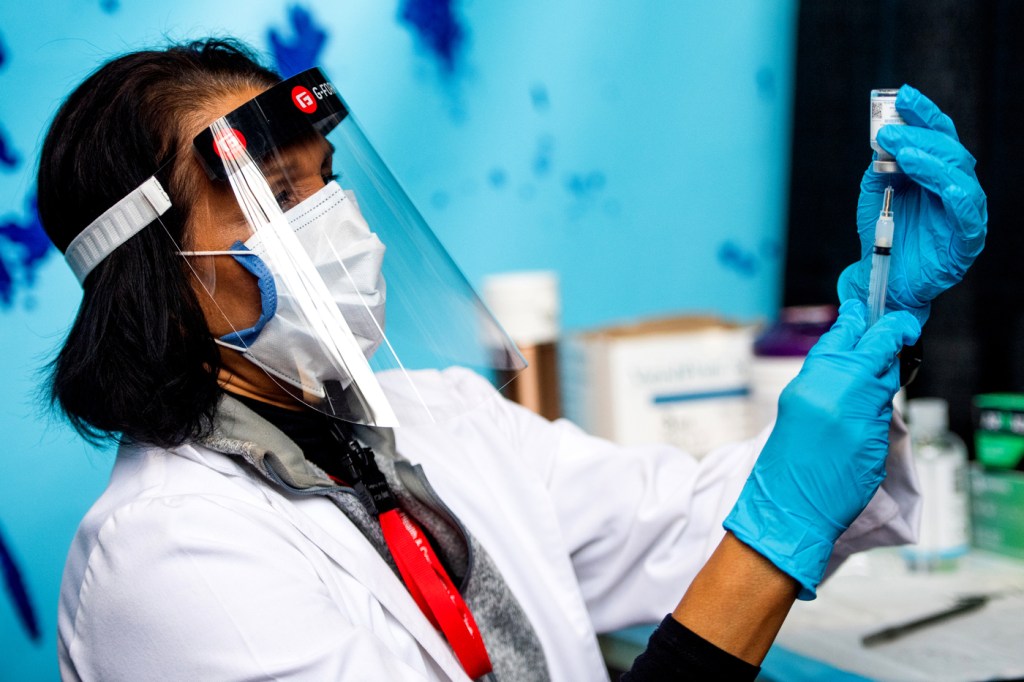Despite partisan divide, workplace vaccine mandates have strong support, study finds

A solid 60 percent of U.S. residents support government-mandated COVID-19 workplace vaccinations, but there was a wide gap between Democrats and Republicans, according to a poll taken after President Biden ordered businesses with at least 100 employees to require vaccination or undergo weekly testing.
The U.S. study by the Covid States Project, a collaborative effort by researchers from Northeastern, Harvard, Northwestern, and Rutgers, found support for workplace immunizations among men and women as well as people of different races, ethnicities, and age groups.
But the study found a partisan chasm of 46 percentage points between Democrats and Republicans, with Democrats overwhelmingly in favor of backing vaccination requirements for businesses—81 percent to 35 percent for Republicans. Independents came in in the middle at 53 percent.

‘It’ll be interesting to see how the OSHA [vaccine mandate] rule manifests,’ says David Lazer, distinguished professor of political science and computer and information science. Lazer is one the lead researchers on the study that found strong public support for vaccine requirements or weekly testing at large companies. Photo by Adam Glanzman/Northeastern University
The findings of the August-September survey of 7,000 U.S. residents may tick a few points up or down once the Occupational Safety and Health Administration, the federal agency that oversees workplace safety, issues a more detailed rule later this year, says David Lazer, university distinguished professor of political science and computer sciences at Northeastern.
“There will be positive or negative reactions accordingly,” adds Lazer, one of the researchers who conducted the study. “It’ll be interesting to see how the OSHA rule manifests.”
Currently, one in four companies have instituted a vaccination requirement and an additional 13 percent of companies plan to put one in place, according to a White House report issued on Oct. 7.
Large companies, each with tens of thousands of employees, such as AT&T, Bank of America, CVS, and others, already have a mandate. The report added that almost 2,500 hospitals, representing 40 percent of all U.S. hospitals, have announced vaccination requirements for their workforce.
“Businesses have more power than ever before to change the arc of this pandemic and save lives,” Biden said at a vaccine event in Chicago.
But the Northeastern-led survey found that 27 percent of respondents opposed workplace vaccine requirements, which may complicate efforts.
Still, researchers found that, outside of the workplace, public support for vaccine mandates overall remains high, increasing slightly in September compared to the summer. They found similar levels of support when they asked respondents if people should be required to get a COVID-19 vaccine to board a flight, go to school, or attend a university.
However, there remained a sharp political divide between Democrats and Republicans on those questions, just as there was on the topic of company vaccine requirements.
Vaccine-hesitant workers at companies impacted by the president’s order could, in theory, bypass the requirement by landing a job at an employer with fewer than 100 employees. “Given the current state of the labor market, it may well be that people can find positions,” Lazer says.
It will become harder, though, if there is a broad-based mandate, he adds. There will still be some employers who are exempt from it. Or, in the case of vaccine-opposed workers in the healthcare industry, they could avoid getting their shots by doing in-home care.
A related Northeastern survey that focused specifically on healthcare workers found that vaccination rates increased 4 percentage points to 77 percent between June and September of 2021, while those resistant to vaccines decreased only 1 percentage point to 11 percent.
In that same four-month span, an additional 4 percent of healthcare workers were immunized, according to the survey. All in all, though, attitudes toward getting the vaccine among the 23 percent of unvaccinated healthcare workers remained mostly unchanged.
The larger takeaway is that even though some healthcare employers are mandating vaccines, “it’s not had a big impact yet,” Lazer says.
Still, newspaper headlines in recent weeks have documented the terminations or resignations of nurses and other healthcare industry employees who refused to get their shots. But Lazer says those numbers can seem misleadingly large when read in a headline or a tweet, when in reality it’s fewer than 1 percent of employees.
“The big lesson here is that the mandates seem to be working, and that there’s a lot less turnover, employee-wise, than some of the headlines suggest,” he says.
For media inquiries, please contact media@northeastern.edu.





